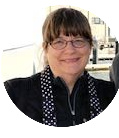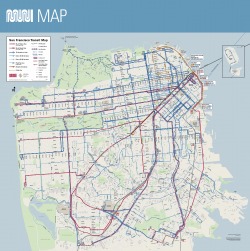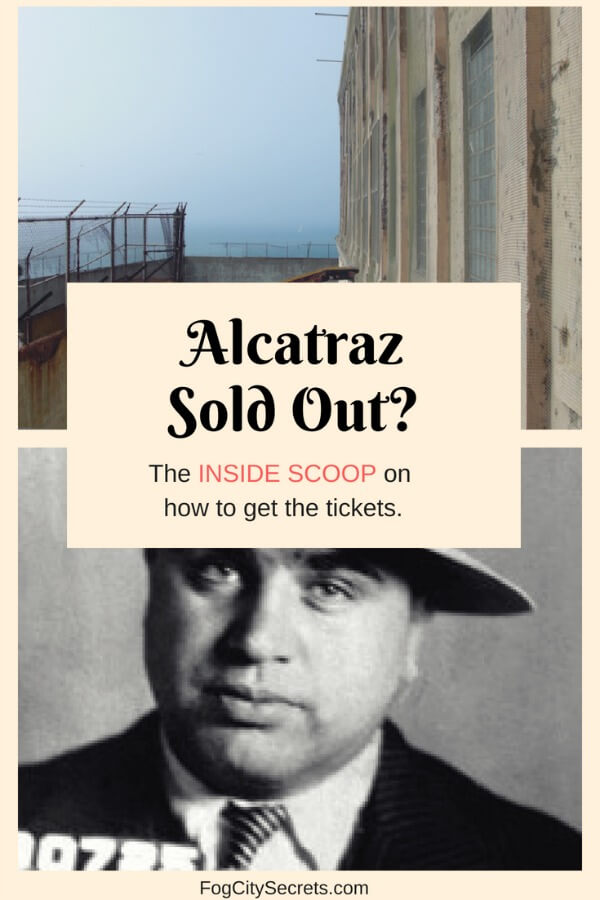- Home
- San Francisco Crime
San Francisco Crime in 2025 - Tips from a Local
Is San Francisco safe for tourists?
The crime stats for the year 2024 are out now, and it's very encouraging! San Francisco still has a long way to go, but it's definitely moving in the right direction.
Many visitors read about crime in San Francisco and wonder just how safe it is to travel here.
There are many opinions on this, and I have my own after living here for many years, but I also wanted to give a more objective and balanced view of this subject.
I collected data on San Francisco crime (and other cities for comparison) from the local police department and FBI statistics.
It's not a pleasant subject, but I think it's important for someone who lives here to share candid information on this issue, along with some safety tips.
Hint: it's not as bad as you've heard...except for the car break-ins! But they are down 54% in 2024! Pretty surprising.
Also, San Francisco's woes with dirty streets, drug addicts and homelessness have been in the news a lot, too. More on that later.
The scoop on SF crime
I want our visitors to have a great experience when they travel here. And with a few safeguards, travelers can enjoy the city without undue worry.
Key takeaways:
- With some precautions, the odds of being a victim of violent crime in San Francisco is quite low.
- The risk of having your car broken into is high...especially if you leave bags or valuables in view.
Most likely, nothing will happen! But forewarned is forearmed. Sorry for the morbid statistics that follow;)
San Francisco's Crime Rate
First of all, how dangerous in San Francisco? Looking at crime rates can help answer that.
Important aspects of SF crime:
- Violent crimes are concentrated in limited areas, mostly not near the tourist areas.
- Crimes most likely to affect tourists are the car break-ins (somewhat preventable).
- San Francisco is not particularly dangerous when compared with other cities, especially U.S ones.
Of course, being a city, San Francisco's crime rate is going to be worse than what you'll find in suburban or rural areas, but it's sort of low to intermediate when compared with other U.S. cities.
And the crime rate in San Francisco varies tremendously by neighborhood, as you would also expect.
There are a handful of areas that seem to produce the lion's share of the crime statistics. Some of these areas are near (but not in) prime tourist spots and others are in areas that tourists rarely see.
Just recently, there were series of muggings near Alamo Square (Painted Ladies) and in Noe Valley, where women were robbed of their cell phones, but it appears that the perps have been identified and arrested (and hopefully will be sent away!).
Good news for tourists: property crimes (thefts, mainly) are way down in the popular tourism spots like Fisherman's Wharf, Pier 39 and North Beach: 60% lower for 2024 vs 2023.
Those dratted car break-ins!
The most annoying aspect of crime for most people in San Francisco is the car break-ins.
They subsided quite a bit during the lockdown, but have risen again due to more people being out and about, including a return of tourists to the city.
There has been a significant drop in car break-ins in 2024, in every neighborhood except one, compared to 2023, so hopefully things are turning around.
Reported break-ins are down 54%, according to SFPD data for 2024 compared to 2023.
But there's one neighborhood in San Francisco where car crime has actually gone up. It's not one of the "usual suspects", in terms of the tourist areas or high-crime areas, where many of the break-ins occur.
It's my old neighborhood, Noe Valley. Noe Valley is an attractive, older neighborhood in the middle of San Francisco, with lots of pretty Victorians, charming shops, and sky-high real estate prices (I rented there, before I moved out to the Sunset District).
Coincidentally, I was living in Noe Valley in the 90s, and had my car broken into four times in one year! (no garage, car parked on the street at night). It's a generally safe neighborhood in terms of violent crime, but still bad for car windows, apparently!
For more details on where the crime in SF is, and crime maps, including the worst car break-in spots, jump to sections on:
Are you planning a visit to San Francisco and want to find a safe place to stay in the city?
I created a guide to the safest areas to stay in San Francisco, with maps of the areas and recommendations for highly-rated hotels in each area.
See safest places to stay in SF. Also recommendations for first-time visitors, visitors with families, and traveling with and without a car. Plus some fun choices.
Current San Francisco Crime Rate
Did the SF crime rate drop in 2024? Yes!
Based on the crime stats for San Francisco through the end of 2024, there has been a drop in both violent crime and property crime.
The crime data presented here is based on reported crimes.
Interestingly, crime levels in SF are now at their lowest since 2001.
The chart below compares numbers of crimes committed in 2024, compared to 2023.
Violent crime is down 14%, and property crime is down 31%. This is a big contrast with crime nationally; violent crime only down 2.4% and property crime only down 0.1%.
The drop in theft is substantial. That includes a big drop in car break-ins...finally! There's a more modest drop for violent crime, but the direction is encouraging. Let's hope this trend continues!
San Francisco just elected a new mayor in November of 2024, whose campaign emphasized the need to deal with public safety in the city.
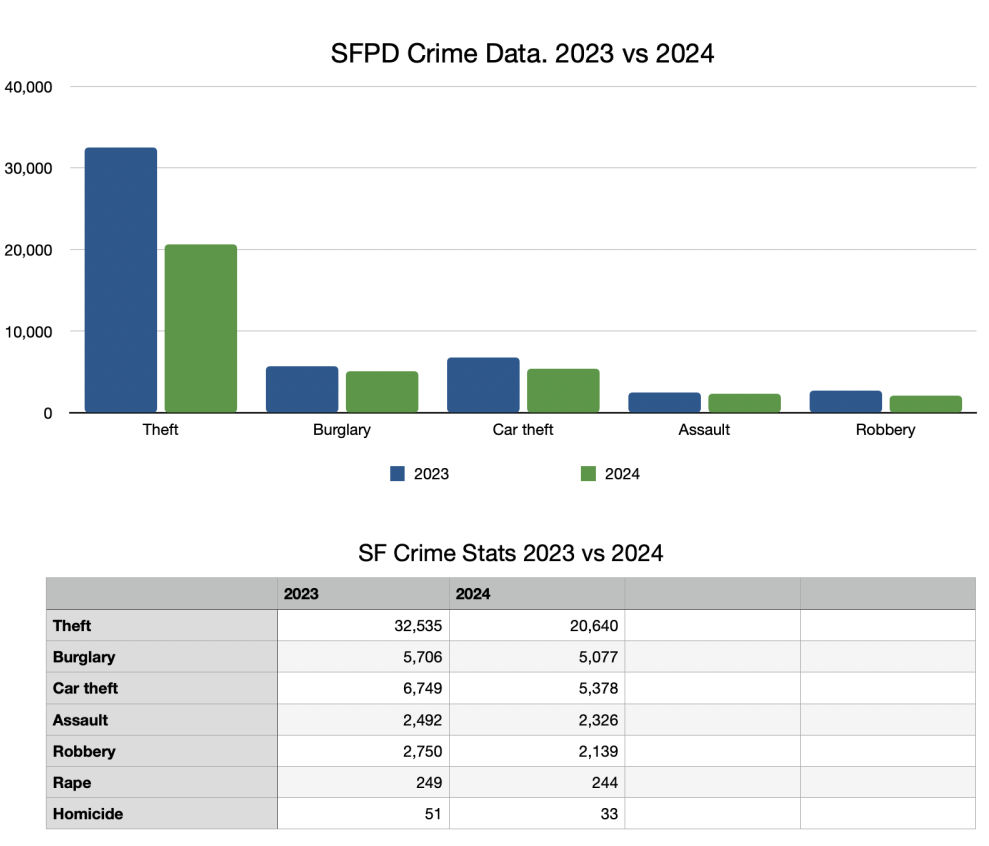
The theft category includes car break-ins.
Violent crime vs. property crime in SF 2024
Property crime in San Francisco has had a much larger drop than violent crime in 2024 compared to 2023.
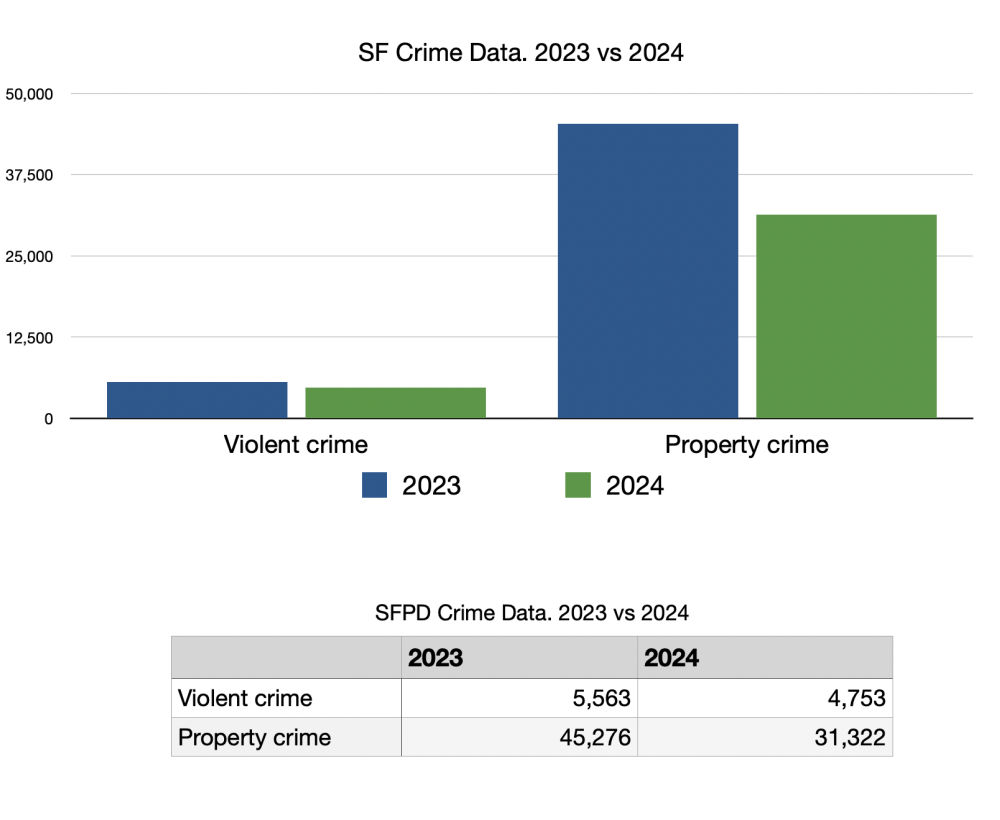
Violent crime is down in all neighborhoods, except the Mission District, where it's up 7% in 2024.
Source: San Francisco Police Department, crime dashboard.
See article in the SF Chronicle about the recent crime drop.
Comparison of robberies citywide: 2023 vs 2024
The maps below show the robbery pattern across San Francisco. You can compare the 2024 pattern with the previous year.
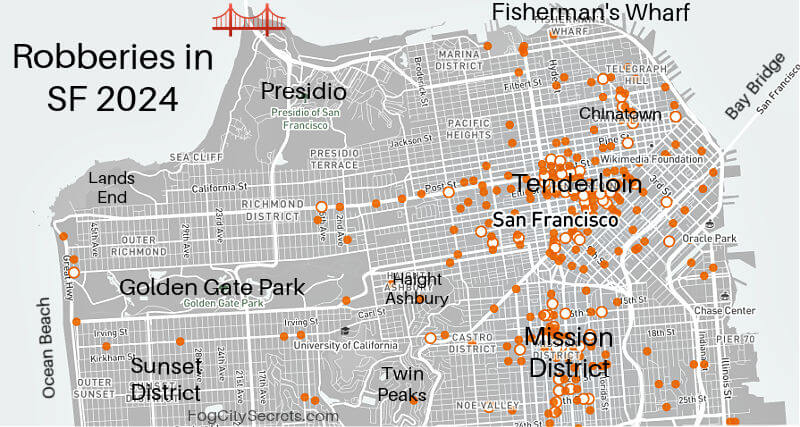 Robberies in San Francisco in 2024
Robberies in San Francisco in 2024It does look like there were fewer robberies in 2024.
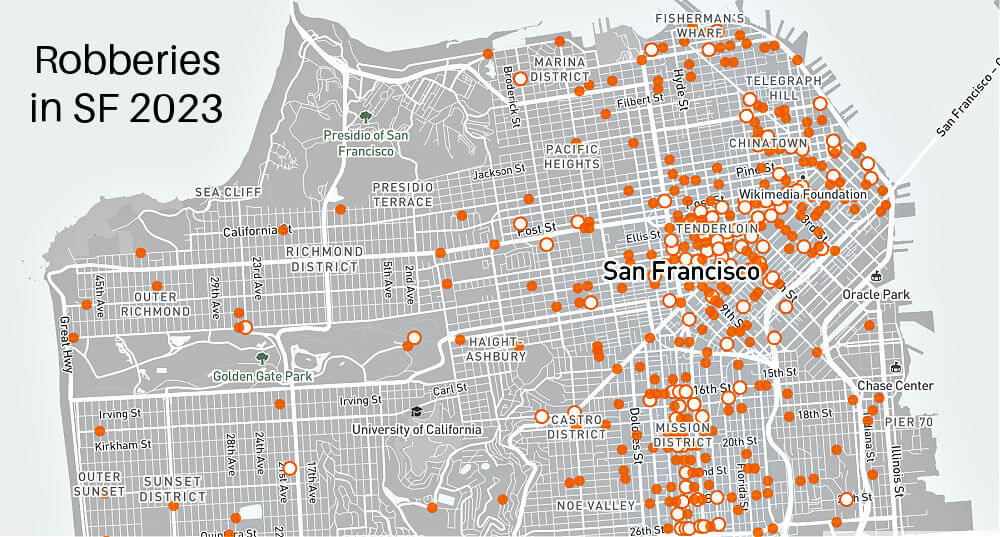 Robberies in San Francisco in 2023
Robberies in San Francisco in 2023SF Crime rate pre- and post- pandemic.
Crime does seem to be dropping overall in San Francisco.
If you compare the crime rate for both violent and property crimes for the pre-pandemic years of 2018 and 2019, there has been a noticeable drop in crime since then, especially for property crime.
The drop in 2024 property crime is particularly pronounced.
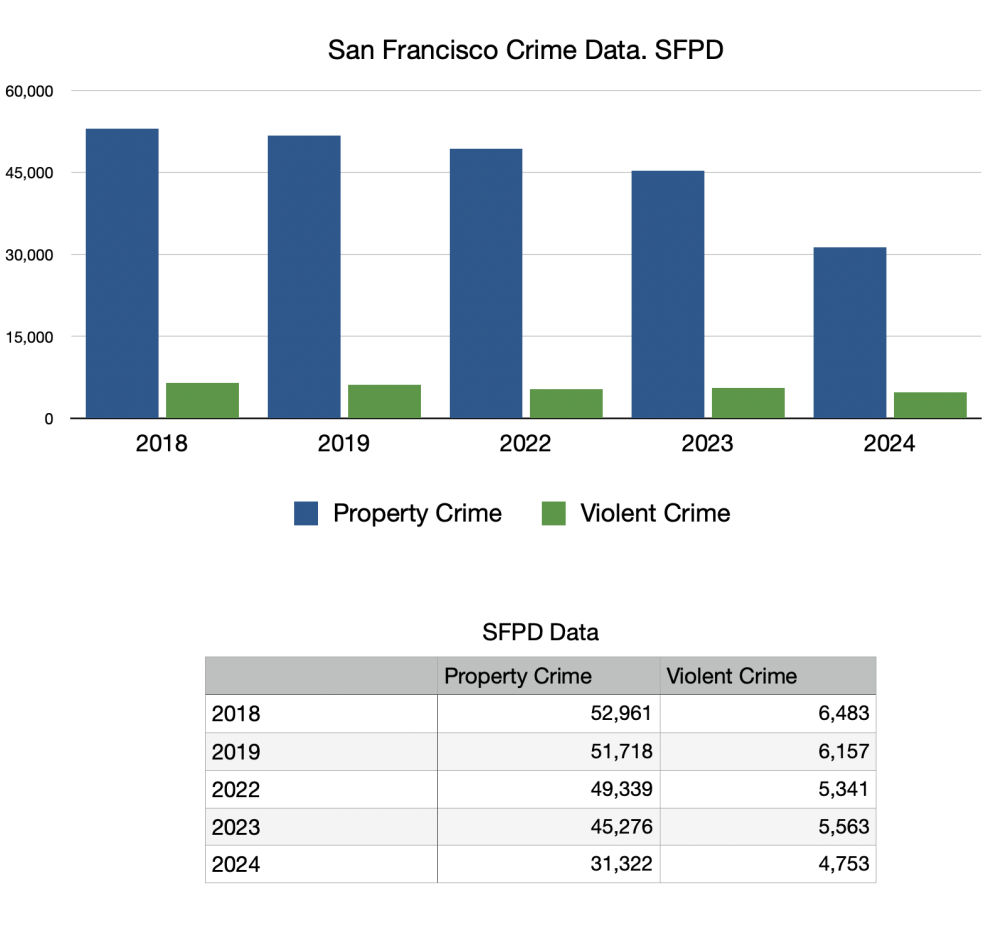
For more details, updated weekly, see the SFPD website.
San Francisco Crime Maps
The Highest-Crime Areas
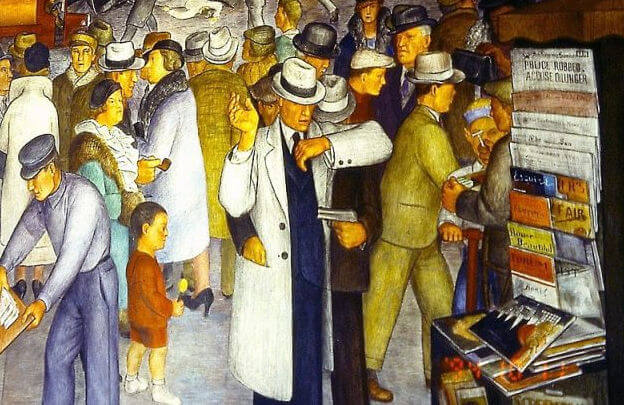 From City Life, by Victor Arnautoff, 1938
From City Life, by Victor Arnautoff, 1938The Depression Era, Coit Tower murals include a scene of some unfortunate being robbed at gunpoint. Not very common in most areas of the city now, fortunately. San Francisco has had crime problems since it's beginning; it's quite tame now, by 19th century standards!
It got so bad during the Gold Rush period, some citizens organized a Committee for Vigilance to take matters into their own hands. The word "vigilante" has its origins with this group. The city government was seen as too corrupt to bring various murderers and robbers to justice. See the Wikipedia article about the Vigilantes' activities.
These are the neighborhoods that generate the most crime reports:
- The Tenderloin District
- Market Street/South of Market
- The Mission District
- Western Addition
- Bayview/Hunters Point
The map below that shows the varying incidence of violent crime across San Francisco.
I chose robberies to illustrate it.
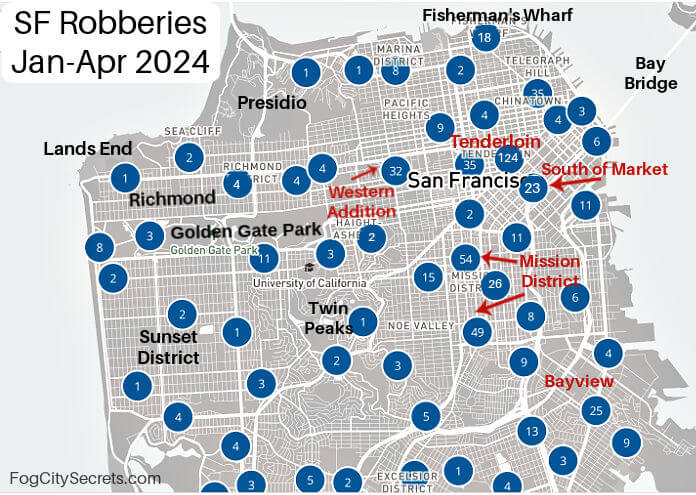
The Tenderloin
The Tenderloin District of San Francisco has the unfortunate honor of being the worst in the city for both violent crime and property crime.
There's a concentration of seedy residence hotels, and many low income residents, along with a higher incidence of prostitution, drug dealing and drug use.
In spite of this, in the daytime even the Tenderloin isn't particularly dangerous in terms of violent crime. At night, it's a different story.
Is there any reason to go there? There are some good restaurants in this area, and some popular music venues. The Great American Music Hall and the Warfield Theater are in the Tenderloin.
Also, the San Francisco theater district near Union Square sits on the edge of the Tenderloin (or just inside it, depending on where you draw the line); the Curran Theater and the Geary Theater (ACT performs there) are two major theaters located about a block west of Union Square.
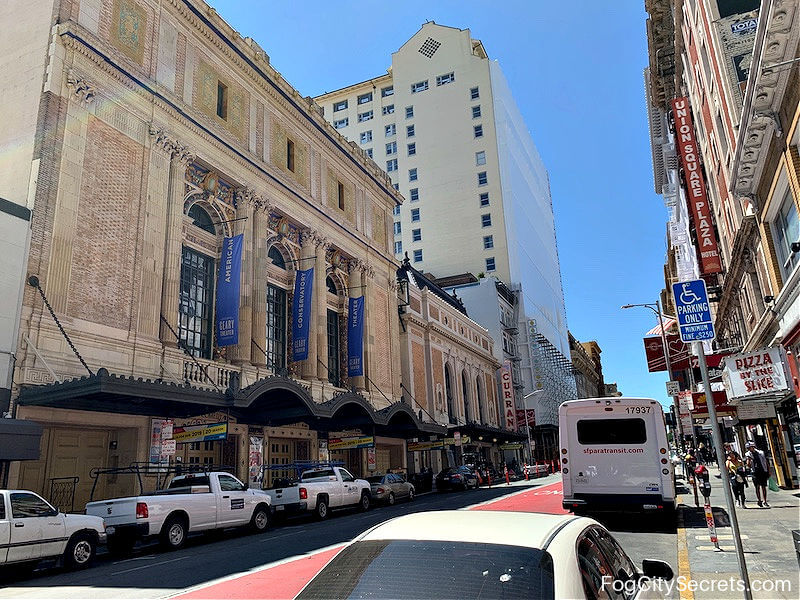 Geary and Curran Theaters
Geary and Curran TheatersMany of San Francisco's most popular hotels are in the Union Square area, just a block from the Tenderloin, but the crime doesn't seem to spill over.
Where is the Tenderloin? It sits in kind of a wedge where Market Street and Van Ness Avenue come together.
The unofficial borders are Market, Van Ness, Geary, Mason and McAllister Streets.
Union Square is one block east and the Civic Center area (SF City Hall, SF Symphony, & SF Opera House) are just to the south.
Map of Tenderloin & Civic Center areas
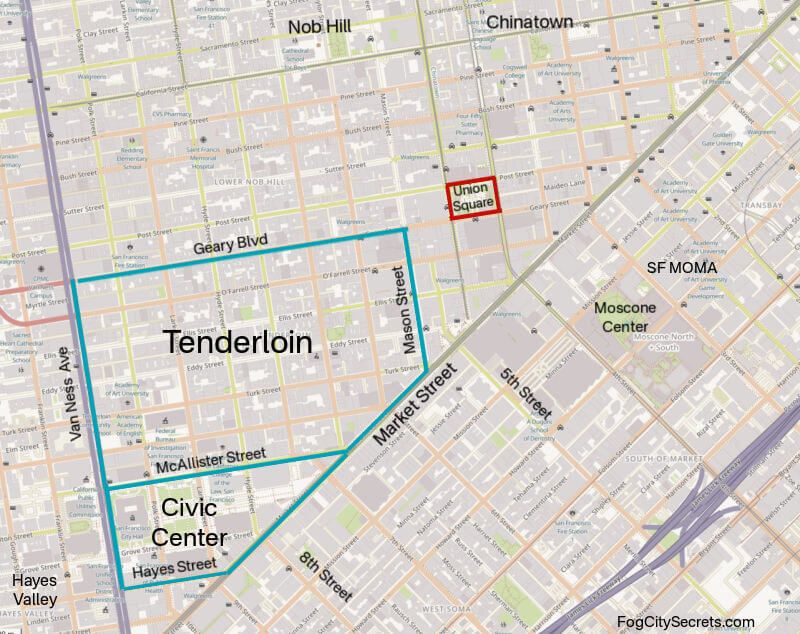 The Tenderloin, Civic Center and Mid-Market areas
The Tenderloin, Civic Center and Mid-Market areasThe area on both sides of Market Street, between 5th and 8th streets (Mid-Market), also has a lot of crime.
Tenderloin robberies...
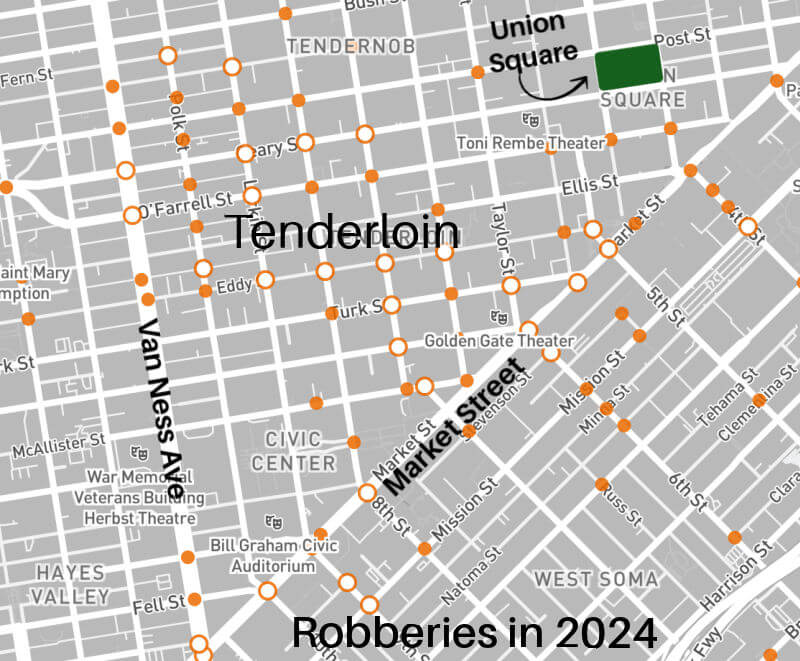
The solid dots in the map above are individual robberies, the white dots multiple robberies.
The crime rate in the Tenderloin in 2024 looks a little better than it did in 2023, but it is still high. This is the location of many of the open air drug markets that the city has been struggling with.
It appears that public pressure has created more of a willingness by the powers that be to deal with the problem. We shall see.
Please don't be freaked out by this map! I included it to illustrate that this is not a great area to wander around in at night.
Data source for above maps: the city has a mapping system for reported incidents of crime. SFPD crime maps.
Other areas with higher crime rates
Attractions in these areas
Western Addition: the main attraction in this area is Japantown, several city blocks of Japanese restaurants and shops, most of which are in the three enclosed malls. Even though this area isn't the greatest, Japantown itself is generally very safe.
Getting there: there are buses that stop right at Japantown, and there are two parking garages in Japantown that are reasonably safe. Parking in adjacent neighborhoods isn't a good idea, however. See Japantown for more info.
The historic Fillmore Auditorium, and the Fillmore District, are also in this area, as well as some popular restaurants like State Bird Provisions.
The Mission District. This neighborhood is a lively, interesting area, mostly Hispanic, with lots of popular restaurants and cool shops. It used to have a higher crime rate, but it's currently "in transition". It's been attracting artists, writers, and, dare I say, hipsters, and is starting to gentrify.
Someone I knew got mugged in the Mission District, coming home from work one evening. He lived in the district, and was young and athletic-looking, and Hispanic, but he was still targeted. But that was about 20 years ago, when it was a rougher neighborhood. About ten years ago, an Irish tourist was murdered during a robbery when he went to withdraw money from an ATM at 2 am on Mission Street; something to be avoided!
There is a lot of night life here, and it isn't all that dangerous in the evening on the main commercial streets (Mission, Valencia, 24th St.) because of all the people out and about, but later at night, and in less-frequented areas like alleys and side streets, it could be a problem. It still has the third-highest crime rate in the city.
Getting there: street parking is challenging, but there are parking lots and garages available. Just try to pick one that isn't too isolated.
BART stations: the two BART stations in the area are not very safe at night, unfortunately: 16th & Mission and 24th & Mission (16th & Mission is worse).
Market Street/South of Market. Not all of Market Street is sketchy.
The area from Powell Street (where the cable cars start) down to the Ferry Building is not that bad. The rough area is Market Street between 5th and 10th Streets.
The Orpheum Theater and the Civic Center BART & Muni station are located in that area, on Market between 7th and 8th Streets.
The Bayview/Hunters Point area is a lower-income, residential and industrial area not generally visited by tourists.
Candlestick Park, the baseball and football stadium (torn down in 2015), was is in this area.
General tips about venturing into these areas:
- During the daytime, it's much less risky, but don't pull out wads of cash or walk glued to a smart screen.
- If you attend a performance in the evening, there will be lots of other people around, arriving and leaving, so there's safety in numbers.
- If you don't want to walk several blocks at night from a bus stop or BART, taxis, Uber or Lyft are a good option.
The SF Police Department makes an interactive map available to research crime incidents in the city.
You can filter by neighborhood, type of crime and time period, and zoom in for more details. See interactive crime map.
See city crime for current SF crime stats.
Is Golden Gate Park safe?
Safe for people, yes. Safe for cars, not so much. You can see on the maps above, it's not a hot spot for robbery. It is one of the most popular areas for car break-ins, unfortunately.
See more about crime in Golden Gate Park and whether you should go there at night.
But the odds are in your favor!
Before you decide not to come here (!), remember that over 800,000 people live here, and that San Francisco had about 25 million visitors in 2018, so the numbers aren't as bad as they look. The 2024 visitor count was almost up to pre-Covid numbers now.
The odds of being one of those numbers are really very slight!
Based on the map stats, there were around 1400 robberies in the first six months of 2019 (pre-Covid, closer to the current 2024 pattern). And there were around 12.5 million visitors during that same period, so there was about 1 robbery for every 10,000 visitors. And most of these robberies did not involve tourists, so the odds are much lower than that.
I included this map to show the variation among the neighborhoods. And most of the violent crimes happen after dark, as you would guess, and many involve drug use, drug dealing, and gang conflicts, which don't affect visitors directly.
That being said, there have been several, high-profile assaults on residents recently by mentally-ill, homeless people which have highlighted the apparent inability or unwillingness of the city to protect its residents from their aggressive behavior.
The mentally ill have to have eight episodes in a year of being found to be a danger to themselves or other people before they can be forced into treatment.
An interesting article discussing the high rate of recidivism among SF criminals and the low incarceration rate.
Pickpockets on the Buses
You're not likely to be mugged on San Francisco buses and trams, but there is a problem with sticky fingers. Be especially observant during busy times of day, when lots of people are packed on.
Keep your purse close to your body, in front of you, and guys, keep your wallet in a front pocket. Keep an eye on mobile phones in purses or pockets. Thieves take advantage of closely packed conditions and purses sitting unguarded.
Sneaky fingers exploring your purse or pockets are much more common on public transit than an open snatch and grab of purses or mobile phones.
The exception: BART passengers.
Be Careful on BART
BART is having an upsurge in robberies with people having their mobile phones or laptops grabbed out of their hands. This typically happens to someone sitting near the door; just as the train is about to leave, the thief grabs the device and runs out of the car, and the car leaves the station.
So be aware while using mobile devices and laptops on BART (or maybe avoid using them if you can, especially while the train is in the station).
Here's an article about BART robberies, and which stations are the worst.
The main risk in SF: car break-ins
Even though the odds are very low of being a victim of violent crime here, unfortunately there is a very high risk of a car break-in. Another good reason to use public transportation.
Auto burglaries have skyrocketed over the past few years and have become an epidemic. Residents are plagued by these, as well.
In 2017, there was a record 31,000 auto burglaries in the city; 2018 was a little better, at 27,000. 2019 was a bit lower at 23,000, but that's still very high. And a discouraging statistic is that only 2% of these resulted in an arrest. And when they are arrested, the sentences are light; not much of a deterrence and very frustrating for us locals!
The actual numbers are probably quite a bit higher because many people don't bother to report them since usually nothing comes of it.
The break-ins dropped in half during the Covid lockdown in 2020, but they climbed back up again, now that people are out and about again, and tourists have returned to the city.
No wonder San Francisco has the highest rate of property crimes of any U.S. city. Our previous District Attorney had campaigned for less incarceration, and followed through on that, but was recalled by the voters in 2022. The current DA is somewhat tougher on prosecuting crime, but it's an uphill battle with SF judges and juries. But 2024 reported a significant drop in car break-ins, and theft in general, so there is hope!
According to the police, most of these are committed by organized gangs; one guy does a quick break-in and another guy is waiting in the getaway car. They're especially hoping for laptops and tablets, and now mobile phones also, so they grab any backpacks or bags they see.
The solution: don't leave anything valuable or visible in your car. Unfortunately, the thieves target cars in the tourist areas.
Good to know: some thieves now have scanners that can pick up Bluetooth signals from electronic devices in the car, so hiding a phone in the glove compartment or a laptop in the trunk won't protect it. You can block the Bluetooth signal by powering down the device or putting it in airplane mode, but it's better not to leave it there at all. See more details on the wired.com article.
Hot spots for car break-ins: Union Square, Fisherman's Wharf, Ghirardelli Square, the Embarcadero (especially near Alcatraz Landing), Golden Gate Park, Lombard Street, Palace of Fine Arts, the Painted Ladies at Alamo Square, Lands End parking lots, and the Cliff House are the prime spots for break-ins. Even though car break-ins dropped dramatically in 2024, it still is a problem to be conscious of when leaving things in your car.
The SF Police Department released a report on the worst spots for car burglaries in San Francisco (see below for list of worst intersections).
Congressman Adam Schiff admittedly ignored the advice and left his luggage in his car in a downtown parking garage when he was visiting the city in April, 2024. Lost his luggage.
Car Break-ins in 2024
Finally some good news! The number of car break-ins has dropped significantly since last year.
I admit I am surprised. The city has been making more of an effort to crack down, and there has been a push to target drug dealers and fencing operations, closely related to car burglary, which seems to be paying off.
Chart showing drop in car break-ins: 2023 vs 2024
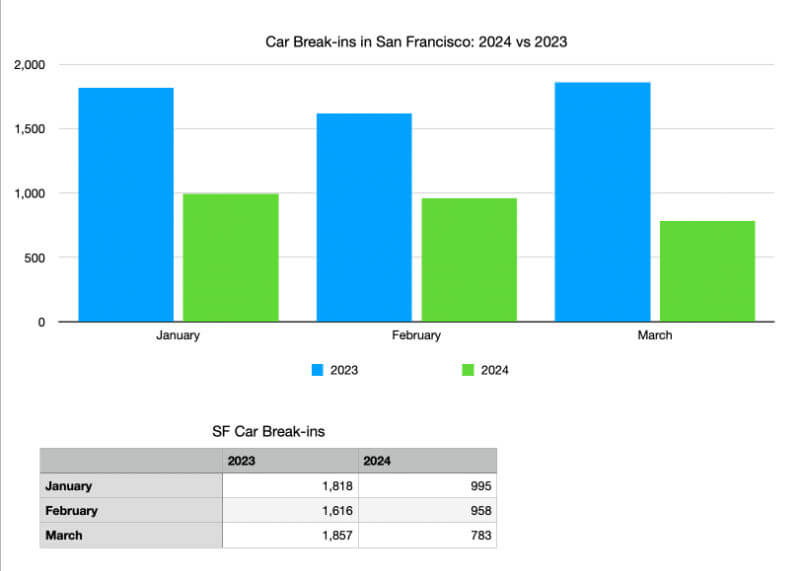
Car break-in map from SFPD data for 2024
The city map produced by the SF Chronicle below shows all the auto burglaries in San Francisco, for a 30-day period up to mid January 2024.
This varies from month to month, with the summer season having the highest numbers, but it gives you a good idea where the hot spots are, relative to popular tourist sites.
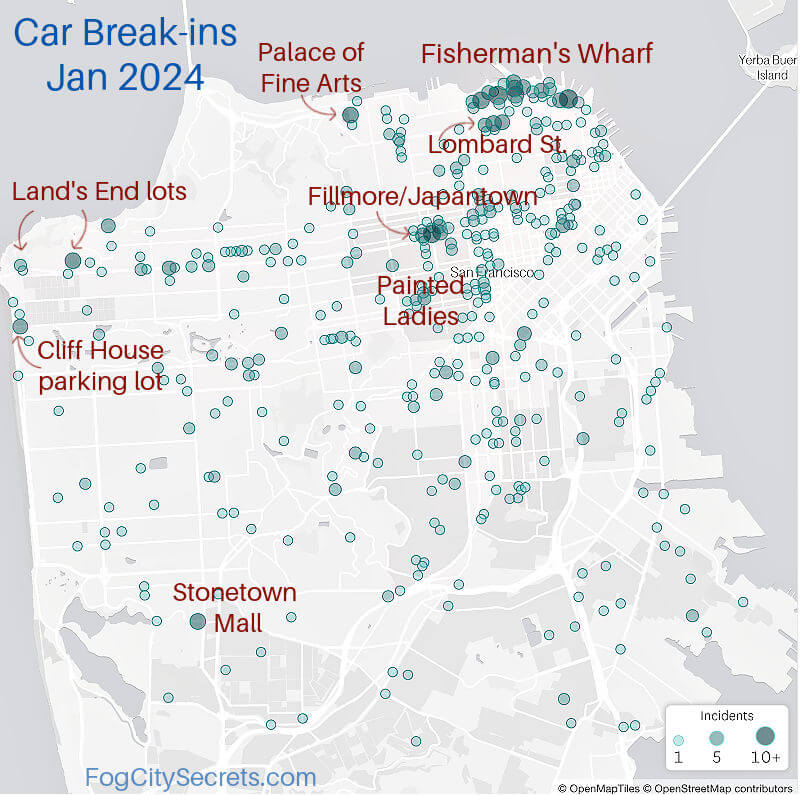
Data source: the SF Chronicle has an up-to-date map of auto burglaries in the city. See SF car break-in map for current numbers.
The SF Chronicle gets their data from the SF Police Department and updates their crime data daily.
You can go to the SF Chronicle website and look at car break-in patterns for any time period from 2018 until the present.
Story of a repeat car burglar
The ABC 7 News TV station in SF did a report on the activities of a thief who breaks into cars in San Francisco.
Very interesting! There are videos of him breaking into bait cars and they follow his case into the courts. He gets released with no bail (big surprise), is caught doing it again 3 days later!
His big mistake; he used his own car with his own license plates. A lot of them use stolen plates or no plates, or stolen cars.
High-season pattern for car break-ins: summer vacation
Tourist season is prime season for car burglars, unfortunately. This map of June 2023 break-ins will give you an idea of where the auto break-in generally occur during the summer season, when San Francisco has the most visitors.
You can see the hardest hit areas are about the same: Fisherman's Wharf, Embarcadero, Tenderloin/Market Street, Golden Gate Park, Western Addition, Mission District, Noe Valley and out by the Cliff House.
Eastern side of San Francisco
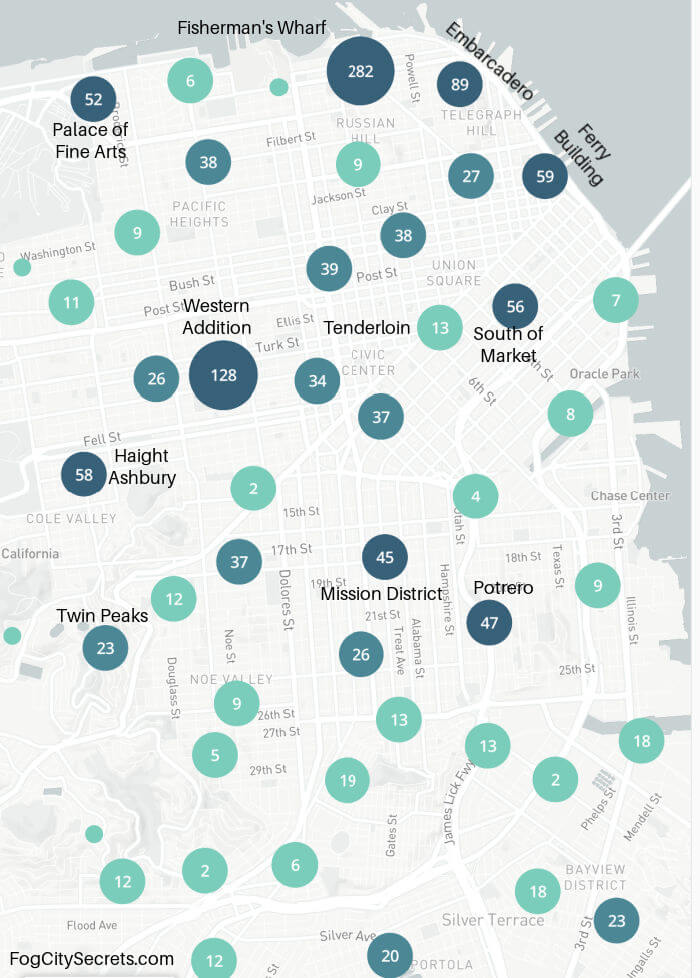 June 2023 car break-ins, east side of SF
June 2023 car break-ins, east side of SFThe tourist areas are some of the hardest hit, especially Fisherman's Wharf.
Western side of San Francisco
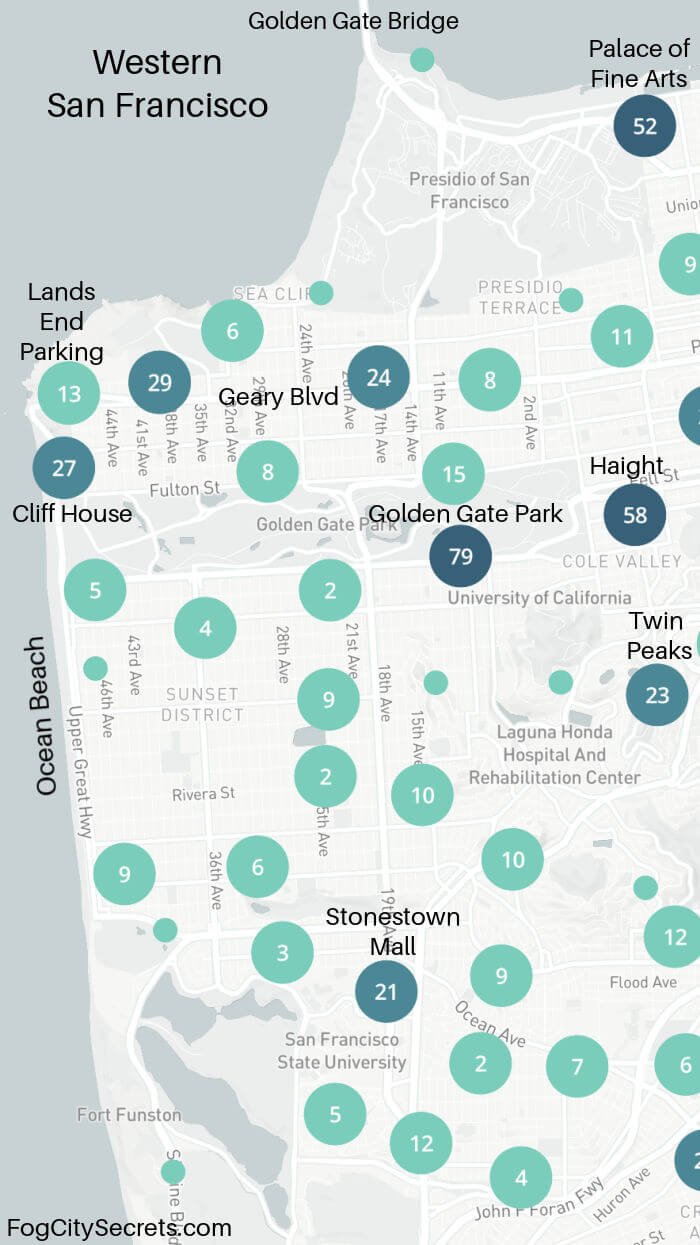 June 2023 car break-ins on west side of SF
June 2023 car break-ins on west side of SFLatest on where not to park
Or at least, where to be extra careful about leaving nothing in your car!
The SF Police Department released a list of the intersections with the largest number of auto break-ins in the past year (July 1, 2022 to June 30, 2023).
The top ten SF intersections for car break-ins (and what they are near), and # of break-ins:
- North Point St. & Larkin St. (Ghirardelli Square) 374
- Francisco St. & Montgomery St. (Alcatraz Landing) 291
- Steiner St. & Hayes St. (Painted Ladies, Alamo Square) 248
- Kearny St. & Francisco St. (Alcatraz Landing) 205
- Taylor St. & Beach St. (Fisherman's Wharf) 199
- 9th Ave & Lincoln Way (Golden Gate Park entrance) 174
- Mason St. & Beach St. (Fisherman's Wharf) 167
- North Point St. & Powell St. (Fisherman's Wharf) 162
- Post St. & Buchanan St. (Japantown) 160
- Columbus Ave. & Leavenworth St. (Fisherman's Wharf) 153
See SF Chronicle article on these hot spots.
How does SF compare with other cities?
Overall, I don't think San Francisco is a particularly dangerous city.
There is crime here, but comparing SF's crime stats with other U.S. cities puts it in perspective.
I used FBI data for 2019 for ease of comparison, from the FBI website.
U.S. Cities. Homicide rate in 2019 per 100,000 residents
|
New York City |
3.81 |
|
San Francisco |
4.51 |
|
Boston |
6.02 |
|
Los Angeles |
6.43 |
|
Oakland, CA |
17.9 |
|
Chicago |
18.22 |
|
Washington, D.C. |
23.71 |
|
New Orleans |
30.71 |
|
St. Louis |
64.67 |
But San Francisco (at 4.5) doesn't do too well compared to many European cities (2017 data):
- Berlin, 2.6
- London, 1.3
- Madrid, 1.2
- Rome, 0.7.
But then there's #1 for 2017: Caracas, Venezuela, at 122.
Unexpected dangers in SF
Aside from crime in San Francisco, there may be some other safety considerations.
Coyotes have gotten the word that there is nothing to fear in San Francisco, from humans anyway, and they have moved in.
They mainly hang out in the large nature-like areas of Golden Gate Park and the Presidio, but they've now become bold enough to walk down city sidewalks in broad daylight, especially in the western parts of the city. My neighbors saw a couple of them casually strolling along the sidewalk, headed for Pine Lake Park near our houses.
They have been aggressively preying on people walking their dogs, even in the middle of the day. In the past, they have generally ignored humans without dogs, but there was recently an attack on a 5-year-old girl playing at a summer camp in the Botanical Gardens, so they can be dangerous to humans as well, especially small ones.
Unfortunately, there has been a rash of attacks on dogs at Baker Beach and Crissy Field Beach, with a number of canine fatalities, so be very careful taking dogs to the beach here.
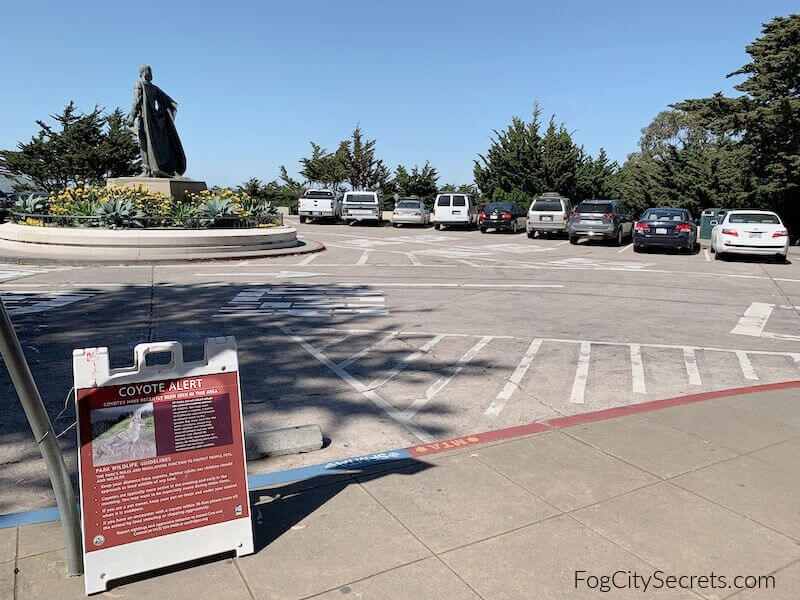 Coyote warning sign in Coit Tower parking lot
Coyote warning sign in Coit Tower parking lotThe city often puts up signs alerting people when coyotes have been seen in an area.
There have been periodic sitings of mountain lions (!) as well in the city limits.
A couple of times cameras have caught the lions prowling around Lake Merced, in the Sunset District (a couple of blocks from my house!) as well as up on Diamond Heights above Noe Valley and the Castro. Marc Benioff, CEO of Salesforce, reportedly saw a mountain lion on his security cameras near his house in the exclusive Sea Cliff neighborhood, near China Beach.
Pretty amazing for such a densely-populated, urban environment! Fortunately, there haven't been any attacks on humans from mountain lions here.
My own experiences with crime in San Francisco
I've never experienced violent crime during my 30 years in San Francisco, but my car has had a bit of a hard time (until I moved out to the Sunset District and got a garage).
When I was living in Noe Valley, my car was broken into four times in one year! Usually after dark. This was awhile ago, when the thieves liked to pull people's stereos out of the dashboard.The main targets nowadays appear to be luggage, backpacks and laptops.
Driving around now, I'm careful never to leave anything in the car, and so far no more break-ins (hope this mention doesn't jinx it!). I mainly use my car to get around the city, and it's parked outside a lot, so I believe the precautions make a difference in reducing the risk. Friends I know that have had their cars broken into had left something visible in the car, like a bag or backpack. Just anecdotal, I realize.
Another time, I was visiting some friends who lived a block from Dolores Park (okay area in the daytime, iffy after dark). When I went to leave, no car! It had been stolen. The police found it the next day, abandoned in another part of the city. Intact, but there was a sewing kit from the Hilton Hotel inside. A mystery.
Homelessness in SF
As you've probably heard, there is a huge problem with homelessness in San Francisco. This is a big topic that I'm not going to attempt to cover here, but the subject often comes up in connection with crime.
In general, the homeless in SF aren't dangerous. Many suffer from mental illness, drug addiction or alcoholism (or some combination of these).
Occasionally some can be belligerent, but generally they are not a threat. The problem is more that large numbers of people living and sleeping (and other things) in the streets have created a health hazard for both residents and visitors.
The city hands out around 400,000 hypodermic needles per month to drug users (yes, per month) and lots of these get thrown into the street. The problem gets worse every year, but the elected officials have been unable to handle it. Nuff said.
But many of the homeless are concentrated in areas away from the tourist areas.
Exceptions: visitors heading into the Tenderloin/Mid Market areas for the theater and concerts will see them, and a number can be seen in the Union Square area as well.
There seem to be fewer in the Fisherman's Wharf area, and not many at all in the western areas of the city near Lands End, the Cliff House and Ocean Beach.
See my article on the homeless situation in San Francisco; latest stats on the problem from the 2024 homeless count, and whether it's getting any better.
So don't worry, be happy...and savvy. Have a great time in San Francisco!
Share this page:
